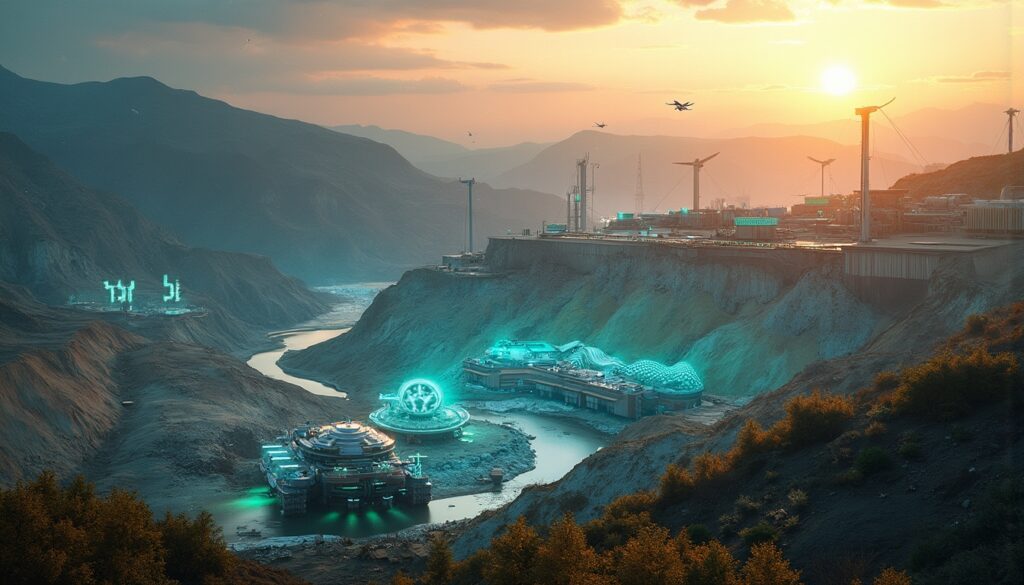What is Driving the Decarbonisation Push in Mining?
The mining industry stands at a crucial crossroads in 2024, facing unprecedented pressure to reduce its carbon footprint. Decarbonisation in Mining 2024/25: Mining is shaping this transformation. According to the International Energy Agency (IEA), mining operations account for 4–7% of global greenhouse gas emissions when including direct operations and indirect activities like refining and smelting.
This substantial impact has placed the industry in the crosshairs of multiple stakeholders. Investor sentiment has shifted dramatically in recent years, with major funds dictating capital flows. Companies are now expected to adopt effective mining decarbonisation strategies that align with global climate objectives.
Investor sentiment has shifted markedly. In 2023, BlackRock announced that 75% of its new investments prioritised companies with credible decarbonisation pathways. Similarly, Norway’s sovereign wealth fund has divested from mining companies lacking clear emissions plans.
Regulatory frameworks are evolving rapidly. The EU’s Carbon Border Adjustment Mechanism (CBAM) adds approximately €80–120 per tonne to high-carbon imports from January 2026. This creates a financial penalty for carbon-intensive operations when exporting to Europe. An insightful iea mining report explains these market shifts in detail.
María Cortés, Head of Sustainability at Anglo American, observes, “The mining industry is witnessing an unprecedented convergence of pressures – financial markets, regulators and end-users are all demanding verifiable reductions.” These pressures underscore the need for Decarbonisation in Mining 2024/25: Mining as a core business strategy.
Perhaps most compelling is the emergence of price premiums for low-carbon materials. Aluminum produced using renewable energy now commands a 10–15% premium in certain markets. Green steel initiatives are similarly incentivising low-carbon iron ore. Analysts project that by 2025, up to 25% of copper contracts will include carbon footprint specifications.
How Are Mining Companies Setting and Achieving Carbon Reduction Targets?
The world’s largest miners have established ambitious decarbonisation targets aligned with the Paris Agreement’s 1.5°C pathway. Companies like Rio Tinto, BHP and Anglo American have committed to net-zero operations by 2050 and set interim targets for 2030. These efforts include setting carbon reduction targets with science-based methods and third-party verification.
Strategies focus primarily on Scope 1 and 2 emissions, which cover direct operations and purchased energy. At BHP’s Escondida copper mine in Chile, a switch to 100% renewable electricity in 2022 eliminated around 3 million tonnes of CO₂ annually. This saving is roughly equivalent to removing 700,000 cars from the road.
Dr Thomas Reynolds, Mining Decarbonisation Specialist at McKinsey, explains, “The most immediate wins are coming from renewable energy procurement; renewable power purchase agreements are now 15–40% cheaper than fossil alternatives.” Such cost benefits are part of the larger transformation narrative within Decarbonisation in Mining 2024/25: Mining.
Scope 3 emissions remain the toughest challenge. These emissions, covering 80–95% of a mining company’s overall carbon footprint, primarily stem from downstream processing. Rio Tinto has taken a pioneering role by investing $2 billion in green steel research with Chinese partners to address these emissions.
Transparency in progress is rising. The Task Force on Climate-related Financial Disclosures (TCFD) framework is now used by 92% of major miners, allowing clear comparisons of decarbonisation progress and fostering authentic carbon reduction over superficial commitments.
What Technologies Are Transforming Mining Decarbonisation?
Electrification remains a mature technology for decarbonising mining. Battery-electric underground loaders and trucks lead the way. Companies such as Newmont have reported energy cost reductions of 40% and maintenance savings of up to 60% compared to diesel operations. This underscores renewable energy innovations in mining that are steadily gaining traction.
Surface operations have been slower to electrify. The energy density required for larger equipment presents challenges. However, prototype innovations such as Caterpillar’s 240-tonne electric haul truck demonstrate the progress being made in the field.
Renewable energy installations are proliferating across remote mines, where diesel costs can exceed $0.30/kWh. At Gold Fields’ Agnew mine in Western Australia, a hybrid wind–solar–battery system with a capacity of 56MW currently supplies 50–60% of the mine's energy needs, with targets to reach 80% by 2025.
Daniel Quiggin, Senior Research Fellow at Chatham House, states, “What’s remarkable is the speed of the renewable transition.” Once deemed experimental, renewables are now the default option for new developments in Decarbonisation in Mining 2024/25: Mining.
Green hydrogen is emerging as a promising solution for high-temperature processes such as alumina refining and metal smelting. Fortescue Metals Group has committed $6.2 billion to develop 15GW of renewable energy capacity by 2030, a substantial part of which will concentrate on green hydrogen production. Energy storage solutions too continue to evolve.
Digital technologies are also playing a pivotal role. For instance, Rio Tinto’s Mine of the Future programme utilises AI algorithms to reduce haul truck fuel consumption by 12.6% through real-time route optimisation. Similarly, Anglo American’s FutureSmart Mining™ initiative has achieved 30% energy reductions in grinding circuits using digital twinning and predictive maintenance.
How Does Decarbonisation Impact Mining Economics?
The economic calculus of mining decarbonisation has altered dramatically. Low-carbon technology investments often carry a higher capital expenditure by 15–40% than conventional methods. Nevertheless, operational expense savings can deliver payback periods of only 3–7 years. Consider Nevada Gold Mines’ solar facility: a $100 million investment that generates annual energy savings of $15–20 million.
Energy cost volatility further drives the shift towards renewables. Mines reliant on diesel or coal face price swings of 30–80%, while long-term renewable power purchase agreements often lock in rates for 10–25 years. This provides much-needed budget certainty.
Melissa Thompson, Energy Transition Lead at Glencore, comments, “The volatility in fossil fuel markets is driving CFOs toward renewables almost as much as sustainability concerns.” This realisation underpins the economic benefits of clean energy for mining companies.
Carbon pricing mechanisms are significantly impacting high-emission operations. For instance, Chile’s escalating carbon tax and Canada’s rising federal carbon pricing could add €160–240 per tonne of copper produced. Such price adjustments may represent 2–4% of a metal’s market value.
Access to capital now depends on credible decarbonisation strategies. Mining companies with top ESG ratings secure debt financing at interest rates 25–75 basis points lower than their less-sustainable competitors. This difference, according to 2023 S&P Global data, translates to millions in annual savings.
What Challenges Must Mining Companies Overcome?
Technical limitations continue to be a major barrier for specific mining applications. Underground operations deeper than 2,000 metres face significant challenges with battery-electric equipment. High-powered ultra-class haul trucks (400+ tonnes) still lack commercially viable electric alternatives.
Grid infrastructure also presents constraints in developing regions. For example, copper mines in southern Peru face a 200MW energy deficit, restricting electrification. In contrast, facilities in the Democratic Republic of Congo contend with grid reliability of less than 50%, forcing reliance on on-site generation.
Supply chain bottlenecks for critical minerals present another paradox. Minerals essential for batteries, such as lithium, face production constraints due to the energy intensity of current processing techniques. This cycle of high emissions and limited decarbonisation options calls for dedicated innovation.
Wei Zhang, CTO at Contemporary Amperex Technology Ltd. (CATL), states, “We’re seeing a circular problem where battery metals themselves face emissions challenges.” Addressing this issue requires breakthrough innovations in mineral processing methods and technologies such as overcoming mining electrification challenges.
Skills shortages compound these technical issues. Seventy-two per cent of mining companies report difficulty recruiting professionals with expertise in renewable energy and electrification. This talent gap can be especially acute in remote regions where competitive compensation packages struggle to attract the right specialists.
How Is the Energy Transition Creating New Mining Opportunities?
Demand for battery metals is entering an unprecedented growth phase. Lithium requirements are expected to increase between 400–600% by 2030. The World Bank estimates that over 3 billion tonnes of minerals will be needed to deploy sufficient wind, solar and geothermal power to meet climate targets.
Several key opportunities stand out:
- Copper is essential for electrification, with electric vehicles requiring up to four times more copper than conventional vehicles.
- Recycling initiatives have grown, with companies like Glencore recovering up to 27 different metals from electronic waste.
- Mine rehabilitation has become a viable option, repurposing abandoned sites into renewable energy hubs.
Goldman Sachs projects an 8.2-million-tonne gap in copper demand by 2030. Michael Rawlinson, former Global Co-Head of Mining at Barclays, warns of extraordinary market dynamics shaped by long development timelines and geological constraints.
Recycling and the circular economy model present substantial energy savings. For rare earth elements, recycling processes can reduce energy use by 60–70% compared to primary mining. Such approaches are becoming an integral part of Decarbonisation in Mining 2024/25: Mining strategies.
What Does a Successful Mining Decarbonisation Strategy Include?
A comprehensive strategy starts with accurate emissions baseline measurement. Leading companies now implement granular energy monitoring across operations, with digital sensors tracking consumption at the equipment level. This data pinpoints high-impact areas and measures progress precisely.
Accountability has become critical. At companies like BHP, Rio Tinto and Vale, 10–20% of executive bonuses are now tied to meeting climate targets. This signals to investors that decarbonisation is core to operational strategy rather than a peripheral initiative.
Successful strategies combine immediate operational improvements with longer-term investments. Immediate wins include:
- Improving haul road conditions to reduce fuel consumption.
- Installing variable speed drives on conveyor systems.
- Retrofitting buildings for better energy efficiency.
These measures typically deliver 5–15% emissions reductions with minimal capital expenditure. Carlos Fernandez, Partner at Boston Consulting Group, notes, “The most successful miners are using a three-horizon approach to capture quick wins, deploy available technologies and invest in breakthrough solutions.”
Community engagement is also vital. Co-development models, where renewable installations benefit both operations and surrounding communities, foster shared value and stakeholder support. For further industry context, industry outlook insights provide a comprehensive review of these shifting dynamics.
Frequently Asked Questions About Mining Decarbonisation
What are the most cost-effective first steps for mining companies beginning decarbonisation?
Energy efficiency improvements offer strong returns. Examples include LED lighting retrofits, variable speed pumps and grinding optimisation. These measures can deliver 10–15% energy reductions and payback periods of under two years. Additionally, load shifting and power factor correction are low-capital, high-impact adjustments.
How are mining companies addressing scope 3 emissions in their value chains?
Innovative methods include Vale’s investment in green pelletising technology, which can lower downstream steelmaking emissions by 10–12%. Anglo American also requires emissions data from equipment manufacturers, while Rio Tinto partners on carbon-free aluminium smelting technology. Such measures bridge gaps in addressing the bulk of emissions.
What policy frameworks best support mining decarbonisation efforts?
Carbon pricing mechanisms with revenue recycling are highly effective. For instance, Chile’s model and Australia’s former Carbon Farming Initiative have encouraged investments in clean technology. These market-based incentives help financialise the benefits of decarbonisation.
Case Studies: Leading Examples of Mining Decarbonisation
BHP’s Escondida copper operation in Chile is a prime example of renewable transition. The world's largest copper mine transitioned to 100% renewable electricity via four power purchase agreements totalling 2,400GWh annually. This change eliminated 3 million tonnes of CO₂ emissions and cut energy costs by roughly 20%.
Rio Tinto has similarly advanced green steel through a $10 million investment with China’s largest steelmaker, Baowu. This partnership focuses on hydrogen-based direct reduced iron technology to lower emissions by 30% by 2030.
Anglo American’s nuGen™ hydrogen haul truck marks a breakthrough in surface mining. This 290-tonne vehicle combines a 1.2MW hydrogen fuel cell and a 1.1MWh battery pack, eliminating the consumption of nearly 900,000 litres of diesel per truck annually. The company plans to convert its global fleet of over 400 trucks by 2030.
Fortescue Metals Group targets net-zero Scope 1 and 2 emissions by 2030, well ahead of competitors. Their $6.2 billion Pilbara Energy Connect programme couples 150MW of solar generation with battery storage and high-voltage transmission for iron ore operations. The separate arm, Fortescue Future Industries, aims to produce 15 million tonnes of green hydrogen annually by 2030.
Conclusion: The Future of Mining in a Low-Carbon World
The mining industry’s shift from carbon-intensive operations to a low-carbon future marks one of the most significant industrial transformations of our time. By 2030, most leading operations will be powered by renewables. Battery-electric and hydrogen equipment are set to replace diesel fleets across both surface and underground environments.
The competitive landscape is changing. Carbon intensity is now a key differentiator for mining companies. Analysts factor future carbon prices into valuations using "carbon-adjusted operating costs." This metric highlights that seemingly low-cost operations may face economic challenges when carbon pricing mechanisms become fully implemented.
Collaboration across the value chain is essential. Initiatives like the Mining and Metals Decarbonisation Initiative bring together 28 mining companies and steel producers to coordinate research and technology pilots. The First Movers Coalition has secured commitments from key manufacturers to purchase low-carbon materials at premium prices.
The mining industry’s role in the broader energy transition is pivotal. As ICMM CEO Rohitesh Dhawan states, "Mining finds itself in the paradoxical position of being essential to the energy transition while simultaneously facing pressure to decarbonise its own operations." The ultimate success of Decarbonisation in Mining 2024/25: Mining strategies will depend on innovation, collaboration and integrated approaches that balance environmental, social and economic factors.
Decarbonisation in Mining 2024/25: Mining is not only a necessity for regulatory compliance but also a significant competitive advantage. The leaders of tomorrow will be those that commit to clean, resilient and community-focused strategies while realising the full economic benefits of the clean energy transition.
Looking to Capitalize on the Next Major Mineral Discovery?
Discovery Alert's proprietary Discovery IQ model instantly notifies investors of significant ASX mineral discoveries, providing actionable insights on both immediate trading opportunities and potentially transformative long-term investments. Explore historic returns of major mineral discoveries by visiting Discovery Alert's discoveries page and position yourself ahead of the market.




